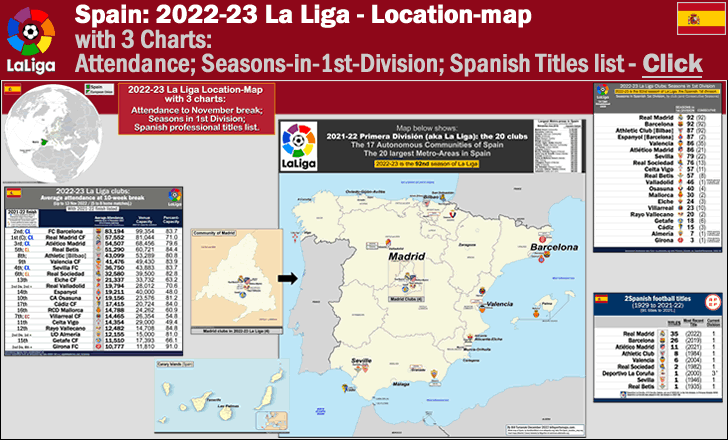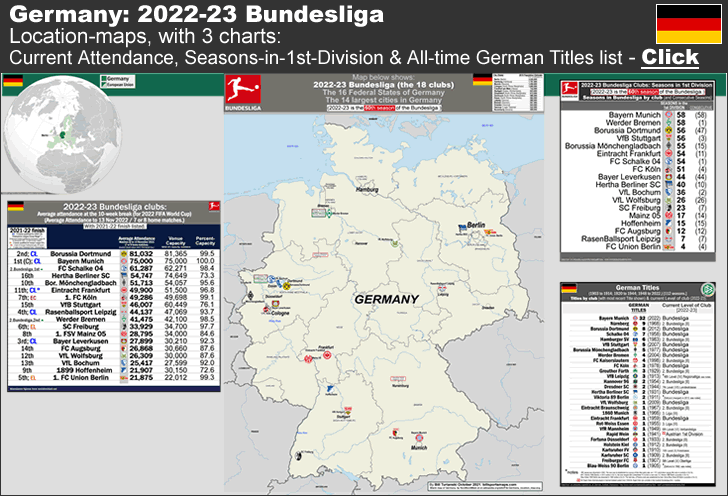
Spain: 2022-23 La Liga – Location-map, with 3 charts: Attendance [current], Seasons-in-1st-Division & Spanish titles list
…
…
By Bill Turianski on 23 December 2022; twitter.com/billsportsmaps.
Links…
-2022-23 La Liga (en.wikipedia.org).
-La Liga – Summary: matches, table, players, etc (soccerway.com).
-Sid Lowe at theguardian.com/football [Spanish football coverage] (theguardian.com/profile/sidlowe).
…
The map page shows a location-map for the 20 clubs in the 2022-23 La Liga, with recently-promoted and -relegated teams noted. (Promoted in 2022: Almería, Real Valladolid, Girona; relegated in 2022: Granada, Levante, Alavés.) The map also shows the 17 Autonomous Communities of Spain, and the 20 largest Spanish metropolitan areas. Those 20 largest Spanish metro-areas, with their 2018 population estimates, are listed at the top-centre of the map-page.
The 3 charts…
A) A chart showing Current Attendance (up to World Cup break of November/December) plus 2021-22 finish, with teams playing in Europe noted. There are also columns listing Venue-capacities and Percent-capacities. The team with the highest percent-capacity currently is newly-promoted Girona, at 91%-capacity. Worst at filling their stadium currently is Espanyol, at 48%-capacity (the stadium is simply too large for the club’s fanbase). Overall, post-Covid restrictions, Spanish football has rebounded pretty well. There are a whole lot of teams playing to ~80%-capacity (Rayo Vallecano, Betis, Cadiz, Valencia, Sevilla, Barcelona, Real Sociedad, Osasuna, Almería, Athletic Bilbao, Real Madrid). (Attendance in Spain is not as good as in Germany, but really, no top flight league (besides the Premier League) ever draws as well as the Bundesliga.)
B) A chart showing Seasons-in-La Liga by club, with consecutive seasons listed. This is the 92nd La Liga season. Three La Liga founding members – Real Madrid, Barcelona, and Athletic Club [Bilbao] have never been relegated.
C) A chart showing the All-time Spanish professional titles list (1929 to 2021-22). There are only 9 clubs which have won a La Liga title, which is a dismally small number, and is an example of how the Spanish game is unbalanced by the near duopoly of Real Madrid/Barcelona.
La Liga will re-start on 29-to-31 December, with the 15th match-week. {worldfootball.net/competition/esp-primera-division.}
…
___
Thanks to all at the following links…
-Blank map of Spain, by NordNordWest at File:Spain location map.svg;
-Globe-map of Spain, by Rob984 at File:EU-Spain (orthographic projection).svg;
-Map of the Community of Madrid, by Miguillen at File:Spain Madrid location map.svg (en.wikipedia.org).
-Map of Canary Islands, by Miguillen at File:Canarias-loc.svg (commons.wikimedia.org).
-Largest metropolitan areas in Spain (2018 European Spatial Planning Observation Network figures) (en.wikipedia.org).
-en.wikipedia.org/wiki/La_Liga#Clubs.
-Autonomous communities of Spain;
-List of metropolitan areas in Spain (en.wikipedia.org).


